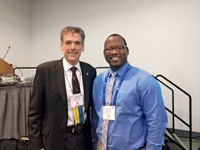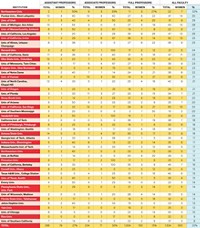Advertisement
Grab your lab coat. Let's get started
Welcome!
Welcome!
Create an account below to get 6 C&EN articles per month, receive newsletters and more - all free.
It seems this is your first time logging in online. Please enter the following information to continue.
As an ACS member you automatically get access to this site. All we need is few more details to create your reading experience.
Not you? Sign in with a different account.
Not you? Sign in with a different account.
ERROR 1
ERROR 1
ERROR 2
ERROR 2
ERROR 2
ERROR 2
ERROR 2
Password and Confirm password must match.
If you have an ACS member number, please enter it here so we can link this account to your membership. (optional)
ERROR 2
ACS values your privacy. By submitting your information, you are gaining access to C&EN and subscribing to our weekly newsletter. We use the information you provide to make your reading experience better, and we will never sell your data to third party members.
Careers
Diversifying Chemistry Faculty
Workshop examines diversity inequity in academia
by Linda Wang
February 28, 2011
| A version of this story appeared in
Volume 89, Issue 9

Efforts to increase diversity among chemistry faculty at Ph.D.-granting institutions have often focused on increasing the number of women and/or racial and ethnic minorities in faculty positions. Much less attention has been paid to supporting other underrepresented groups, such as people with disabilities or those in the lesbian, gay, bisexual, and transgender community.
To expand the scope of these diversity efforts, the National Diversity Equity Workshop, held last month in Arlington, Va., brought together nearly 50 chairs of chemistry departments or their faculty representatives to understand the effects of bias and to discuss approaches to improving minority representation.
The event, supported by the National Science Foundation, the Department of Energy, and the National Institutes of Health, was the first in a series of workshops planned by the newly formed Open Chemistry Collaborative in Diversity Equity (OXIDE) initiative.
OXIDE is a five-year effort to study, track, and share data about diversity equity among leading research-active doctoral-granting chemistry departments around the U.S., said Rigoberto Hernandez, director of OXIDE and professor of chemistry at Georgia Institute of Technology. The initiative is a response to the America Competes Act, which, in part, encourages universities to collect data on the demographics of academic departments and to create workshops to facilitate the flattening of diversity inequities that may exist in academic culture.
During the equity workshop, the participants listened as social scientists described past research on hidden biases that may contribute to diversity inequity. The participants also learned about various ways to help change existing mind-sets. They then gathered in breakout groups to discuss possible steps they can take at their own institutions.
“The department heads are the agents of change,” Hernandez said. “They have the power to create programs that will move them toward diversity equity and place them in a more competitive position.”
Hernandez said that by including social scientists in the discussion, chemists can gain a better understanding of the underlying causes of hidden biases and learn how to counteract them. “We are making a clearer statement of how chemists can work together with social scientists to actually make change that’s effective,” he said.
Chemistry department heads can get overwhelmed by the different diversity groups they need to focus on, said workshop participant Isiah M. Warner, a chemistry professor and the vice chancellor for strategic initiative at Louisiana State University. “It’s going to benefit the entire effort of diversity to have chemistry departments think of diversity as a single effort rather than multiple efforts,” he added.
Karl S. Booksh, a professor of analytical chemistry at the University of Delaware, said he’s encouraged that the workshop is including the voice of the disability community. “I think it’s significant that we have this many chairs of chemistry departments who recognize that disability is worth talking about,” he said.
During his talk, Larry Wagner, representing the National Organization of Gay & Lesbian Scientists & Technical Professionals, asked workshop participants to raise their hands if they had an openly gay colleague in their department. Eight hands went up. When asked how many departments had more than one openly gay colleague, only two hands remained up. Wagner pointed out that, on the basis of statistics, the number of raised hands should have been much higher. The low number suggests that being openly gay in the workplace is still not seen as acceptable, he said.
Workshop participants were optimistic about the ability of chemistry departments to stimulate change, but they were also realistic about how quickly this change could come. “I think it’s good that these conversations are being had,” said Malika Jeffries-El, an assistant professor of chemistry at Iowa State University. “I think the change is going to be slow though.”
“I’m not sure I’m hearing enough new ideas yet” to accelerate change, said Cynthia J. Burrows, a professor of chemistry at the University of Utah. “I feel like we’re still working on the same sort of ideas that have been talked about for several years.”
Burrows also wondered why there wasn’t more representation of women and minorities among the workshop participants. “I’m a little disappointed as I look around the room that there are not more women and minorities who are holding a position of chair,” she said. “There really ought to be more people and more diversity in this room.”
The tough economic times and hiring freezes weighed heavily on the minds of some participants as they considered the cost of potential changes. “Chemistry departments are having their budgets cut from them,” said Michael P. Doyle, chairman of the department of chemistry and biochemistry at the University of Maryland. “We’re willing to spend enough money to do a little bit of social science research, but are we willing to spend enough money to correct the problem?”
Burrows pointed out that some changes can be made without spending a lot of money. For example, she said, chemistry departments can make sure that more women and minorities are reflected in their choice of seminar speakers. “It doesn’t cost anything to do that, but it can influence the way graduate students view the field of academic research,” she said.
“If we can go back, and each of us report just a couple of good ideas and actually see those implemented, I would consider that a success,” Burrows added. “They don’t have to be big things, they can be small things.”
Participants agreed that there’s no time to waste. “We have to address the problem now,” Warner said. “We can’t wait until 20 years from now. I worry that people will put off addressing diversity issues until it becomes a crisis.”
Plans to host another workshop in 2013 are under way as part of OXIDE. In the meantime, initiative leaders are conducting an annual demographic census of all research-active departments and will assess the actions performed within those departments. The data generated from the census will be published annually in C&EN, with the first one expected later this year.
“I look at OXIDE as a service organization to the departments,” said Timothy M. Swager, assistant director of OXIDE and a chemistry professor at Massachusetts Institute of Technology. “We’re trying to come up with new approaches to helping you solve the problem.”
Hernandez hopes that, within one year, a percentage of the departments will implement programs that support diversity equity. “We’re looking for short-range actions that will lead to long-term positive consequences,” he said.
And at the very least, OXIDE hopes to get more department chairs to think about the importance of diversity. “If we continue to grow those numbers of department chairs who are committed, I think things have to change,” Warner said.





Join the conversation
Contact the reporter
Submit a Letter to the Editor for publication
Engage with us on Twitter